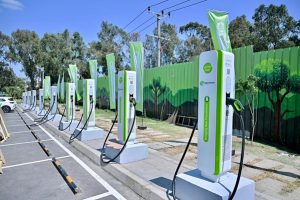
Ethiopia is witnessing a remarkable transformation in its ride-hailing industry, with the share of electric vehicles (EVs) steadily rising. Platforms like Yango now boast over 10 per cent of their fleets as EVs-an impressive jump from less than 1% just a year ago. This surge is largely driven by the Ethiopian government’s commitment to sustainable transportation, aiming to reduce reliance on imported fossil fuels and enhance environmental resilience.
Key government initiatives have created a favorable environment for EV adoption. Import duties on EVs have been significantly lowered, and infrastructure development is gaining momentum, with plans to expand the national charging network and significant investments in electric buses. Financial incentives are encouraging both private and commercial uptake of EVs, particularly in the ride-hailing sector. Together, these measures are nurturing a robust shift toward electric mobility, positioning Ethiopia as a leader in green urban transportation across Africa.
Among the most sought-after electric vehicles in Ethiopia today are the BYD Seagull and Changan Benben E-Star-models that have quickly gained popularity among ride-hailing operators and private consumers due to their affordability, energy efficiency, and low maintenance requirements. As awareness of these benefits spreads, many ride-hailing drivers are actively selling their internal combustion engine (ICE) vehicles to transition to EVs, motivated by clear financial incentives.
One of the most compelling advantages driving the transition to EVs in Ethiopia is the dramatic difference in operating costs, particularly amid the country’s escalating fuel prices. Over the past year, gasoline prices have skyrocketed from ETB 91.14 to ETB 122.53 per liter-a 34% increase-while diesel and kerosene prices have followed a similar trajectory. This steep rise is primarily attributed to the government’s strategic move to phase out fuel subsidies and align domestic fuel costs with global market rates. In stark contrast, Ethiopia continues to offer some of the cheapest electricity in the world, with average rates between ETB 2 and 10 per kWh, depending on the type of EV charging infrastructure.

For ride-hailing drivers, this cost disparity has profound implications. A typical ICE vehicle, such as a Toyota Vitz, Yaris, or Suzuki Dzire, consumes more than ETB 1,100 worth of fuel daily to cover 100 kilometers across ten ride-hailing trips. Meanwhile, an EV like the BYD Seagull can travel the same distance for less than ETB 100 in electricity, assuming a consumption rate of 10 kWh per 100 km and an electric cost of ETB 10 per kWh. This 90% cost reduction translates to monthly savings of over ETB 30,000-or nearly ETB 360,000 annually-providing drivers with a substantial boost in income while reinforcing the economic case for EV adoption.
The automotive market is experiencing significant shifts: used ICE vehicle prices are falling, as illustrated by the drop in the price of a 2008 Toyota Corolla from ETB 2.2 million to around ETB 1.7 million. In contrast, the BYD Seagull, now being sold for ETB 2.8 million, has seen price hikes due to surging demand. These dynamics signal a fundamental realignment in consumer priorities, with economic efficiency and sustainability emerging as key drivers of vehicle choice in Ethiopia.
Considering the profitable unit economics of EVs, small-time investors are increasingly investing in EV fleets for deployment on ride-hailing platforms. For example, an investor with ETB 9 million can choose between purchasing an apartment as a rental property or buying four Changan Benben E-Star or comparable EV models. A rough calculation shows that the return on investment for a fleet of four EVs is estimated to be over 35% annually, with each EV generating approximately ETB 70,000 in net monthly income on platforms like Yango, resulting in a combined total of ETB 3.4 million per year. In contrast, renting an apartment would yield around ETB 35,000 monthly (or ETB 400,000 yearly). Given that the days of high price appreciation for apartments in Addis Ababa are over, investing in an EV fleet for ride-hailing is proving to be a more profitable option.
Despite the clear advantages, some ICE vehicle owners remain skeptical about transitioning to EVs. Concerns about battery longevity, replacement costs, and the resale value of used EVs contribute to their hesitation. However, as the infrastructure and market for EVs mature, these concerns are likely to diminish.
Yango’s long-term sustainability goals are centered on building a robust electric ride-hailing ecosystem in Ethiopia. By partnering with local stakeholders and ensuring that EVs are accessible and affordable, Yango aims to lead the charge in sustainable transport. To differentiate itself in the rapidly evolving ride-hailing market, Yango is focusing on technology and localization. This includes enhancing its app with AI-powered features, adapting services to meet local needs, and investing in driver empowerment through education and flexible earning models.
The transition from internal combustion engine (ICE) vehicles to electric vehicles (EVs) in Ethiopia’s ride-hailing industry marks more than just a passing trend—it signals a transformative redefinition of urban mobility across the country. Driven by a bold government ban on ICE vehicle imports and reinforced by a suite of progressive policies and incentives, Ethiopia has laid the groundwork for a cleaner, more cost-effective transportation future. Platforms like Yango are actively embracing this shift, spearheading the integration of EVs into their operations and helping to normalize electric mobility as both practical and profitable. With fuel prices soaring and electricity remaining remarkably affordable, the economic case for EVs has become increasingly compelling, prompting widespread adoption among drivers.
Despite infrastructure and maintenance challenges, the trajectory is clear: Ethiopia is positioning itself as a trailblazer in sustainable urban transport, with the ride-hailing sector serving as a powerful catalyst. As this momentum continues, the nation stands poised to become a leading example of how visionary policy, market dynamics, and private sector innovation can converge to shape a greener, more resilient future for mobility in Africa and beyond.
BY STAFF REPORTER
THE ETHIOPIAN HERALD FRIDAY 27 JUNE 2025





